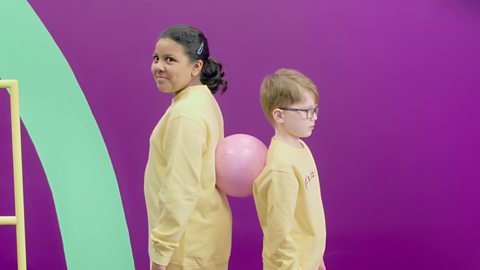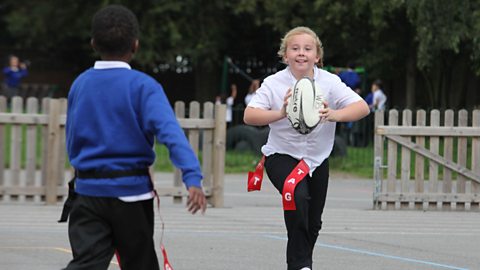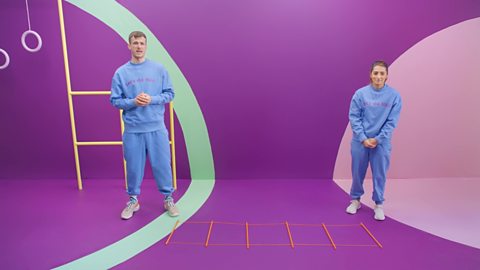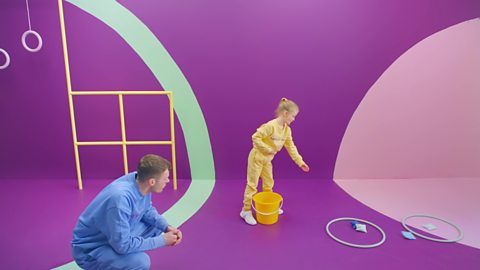Let's get active and try Don't Drop The Ball!
With the Don't Drop The Ball activity you can develop the following skills:
- Focus and concentration
- Teamwork and communication
- Problem solving and creativity
- Coordination and fluency
- Balance and control
This resource is suitable for Physical Education and activity for P2, P3, P4, P5, P6 and P7 (First and Second Level Curriculum for Excellence).
Watch this
Learn how to take part in the Don't Drop The Ball activity with help from primary school teacher, Danny Denholm.
DANNY: Hey, I'm Danny. Welcome to let's do this. Where we will get active together.
This activity is called Don't Drop The Ball.
This is a great game for developing your focus, communication and concentration.
You will need a partner, a ball or a balloon.
Can you guess what we'll be trying to do?
To show you I've got Louis and Nia with me.
NIA and LOUIS: Hi.
DANNY: Step one. Stand back to back.
Step two. Place a ball or object between your backs.
Step three. Try to work together to a seated position.
And back to a standing position without dropping the object.
Do you think you could give this a try?
NARRATOR: Too tough?
DANNY: You could use a larger ball or object, or you could even try using a balloon rather than a ball.
But be careful. You can burst it.
NARRATOR: Go up a notch?
DANNY: For more of a challenge. Why not try using a smaller object?
We are going to use a tennis ball.
To add even more challenge, create an obstacle course to complete before sitting and standing.
Finally, you can also do it against a timer.
How quickly can you complete your course?
NARRATOR: Danny's challenge.
DANNY: My challenge is really tricky.
Try to sit and stand three times in a row without dropping the ball.
NARRATOR: Final Thoughts.
DANNY: That's a really challenging test of teamwork.
So don't worry if you struggle, it's important you keep showing that resilience when things get tough.
We can do it.
*NARRATOR: Let's do this
What you need
| Equipment | Alternatives |
|---|---|
| Ball | Balloon |
Try it yourself
Follow these step-by-step instructions and give it a go!

Image caption, Get into position
Both partners stand back to back and place your ball (or other object) between your backs.
Image caption, Sit down
Work your way into a seated position without dropping the object between your backs.
Image caption, Stand back up
Try to stand up without dropping the object between your backs.
1 of 3
Don't have a partner?
If you want to practise this on your own, use a wall or flat surface instead of another person.
How was Don't Drop The Ball for you?
We are all unique and have different strengths and skills. Some of us may find some skills easier than others but we can all develop and improve.
You can adapt the Don’t Drop The Ball activity to suit your needs. If we practise our skills regularly, we can improve and progress over time.
Too tough?
If you find Don't Drop The Ball too challenging, don't worry!
Try these tips to make the activity a bit easier.
- You could use a larger ball.
- You could use a balloon instead of a ball. Just be careful not to burst it!
Go up a notch?
It's great to look at ways to develop our skills and we can do this by challenging ourselves.
If you enjoyed Don't Drop The Ball but are looking for a bigger challenge, try these tips to make it trickier.
- You could try using a smaller ball. This will be trickier to hold between your backs. Tennis balls or golf balls are good options.
- Add in obstacles to complete before sitting down. For example, you could weave around some cones or step over some objects.
Danny's challenge
Sit down and stand up three times in a row without dropping the ball.
If you manage that, keep going and find out how many you can do in a row.
Time to reflect
Enjoyment
The most important part of physical activity and movement is that you enjoy it. We all need to stay active in our daily lives in order to stay healthy. It’s a lot easier if you’re having fun.
After you’ve taken part in this activity, take some time to think about what you enjoyed and how you might approach the activity differently next time.
- What did you enjoy about this activity? How could you do more of this?
- What did you dislike about this activity? What would make it better?
- What would you do differently next time?
Developing your skills
The skills you’ve worked on in this activity are useful in other parts of your daily life and in sport.
Can you think of any activities or sports where you might use these skills?
The skills you've developed in this activity could help with:
- balancing in gymnastics
- communicating between teammates during sport
- problem solving in team activities
Physical activity skills. listPhysical activity skills
Learn more about the different skills you've developed in this activity and how we use them in daily life.

More on Physical activity
Find out more by working through a topic
- count8 of 18

- count9 of 18

- count10 of 18

- count11 of 18

